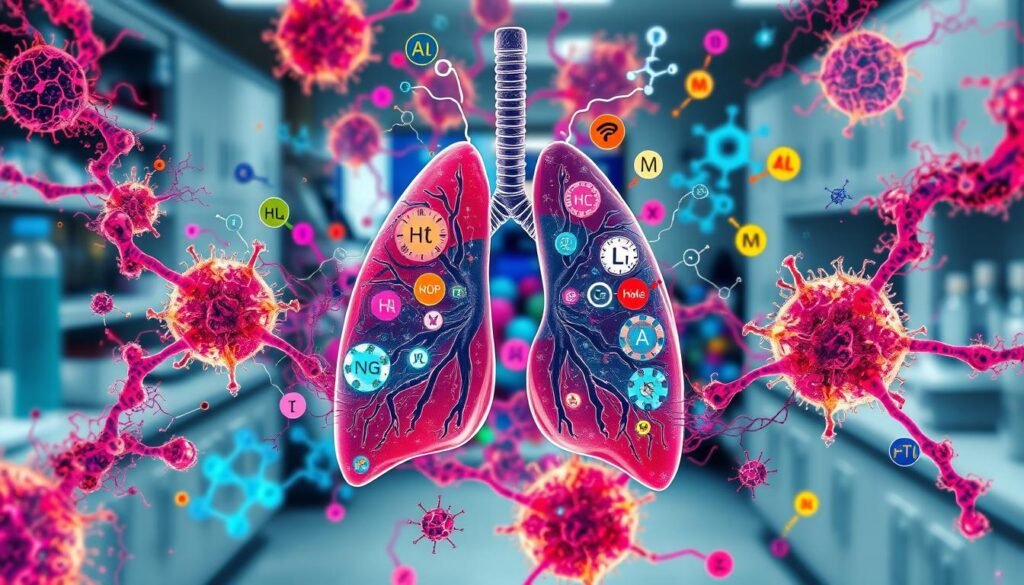Did you know about 10% of lung cancer cases involve paraneoplastic syndromes? These conditions result from tumor activity far from the main tumor site. They spark symptoms that make the disease more complex for patients. Lung cancer is a top cause of cancer-related health issues. So, it’s key to grasp the effects of paraneoplastic syndromes on diagnosis and care.
Paraneoplastic syndromes can impact several body systems like the nervous, endocrine, and blood systems. These conditions often appear before lung cancer is even found. They play a big role in how well the patient does and their life quality. Important research shows that issues like SIADH and HHM are major endocrine issues linked to lung cancer. Knowing about these syndromes is more crucial now than ever.
We’ll look into the various paraneoplastic syndromes linked with lung cancer, their symptoms, how they’re diagnosed, and ways to manage them. Understanding these complex syndromes is vital for caring for patients well. It could also lead to better, more focused treatments.
Key Takeaways
- Paraneoplastic syndromes occur in about 10% of lung cancer cases.
- Endocrine syndromes like SIADH are common in lung cancer patients.
- Neurologic paraneoplastic syndromes can affect 3% to 5% of small cell lung cancer cases.
- Symptoms of paraneoplastic syndromes can manifest before lung cancer diagnosis.
- Understanding these syndromes is crucial for improving patient outcomes.
Introduction to Paraneoplastic Syndromes
Paraneoplastic syndromes are complex disorders linked to cancer. They’re not caused by the cancer itself but by the body’s reaction to it. Knowing about these syndromes helps doctors treat lung cancer effectively.
Lung cancer, especially the small-cell type, often brings these syndromes to light. They affect different parts of the body. Paraneoplastic syndromes awareness is key for both doctors and patients. It’s vital because these syndromes appear in about 20% of cancer cases. They can cause anything from hormone issues to severe nervous system problems.
A common issue with small-cell lung cancer is hypercalcemia. This means too much calcium in the blood. It can make the patient’s condition worse and complicate treatment. Managing this is critical for the patient’s health and recovery. For more details on this, check out this article.
Spotting lung cancer paraneoplastic syndromes early makes a big difference in treatment. Quick action improves patient care and their chances of getting better. Understanding these syndromes is crucial for good health outcomes.
What is Paraneoplastic Syndrome?
Paraneoplastic syndrome is a group of symptoms that happen in cancer patients. These are not caused by the tumor itself. Instead, they come from the body’s response to the cancer. This can affect various systems like the nervous and endocrine systems.
These syndromes show how the body can react in unexpected ways to cancer. It goes beyond just where the cancer is located.
With lung cancer, paraneoplastic syndrome often shows unique symptoms. Patients may experience problems with their endocrine system or nerves. For example, some develop hypercalcemia, which is a severe condition from too much parathyroid hormone.
This makes treating cancer harder. It also impacts how doctors diagnose the disease and the results for the patient.
Recent studies on paraneoplastic syndromes have shown how onconeural antibodies play a big role. These antibodies can cause autoimmune responses in the body. This leads to neurological disorders that can greatly affect a person’s life.
Finding these markers can help doctors find hidden cancers, such as lung cancer. This can be critical for the patient’s care.
Paraneoplastic Syndrome Lung Cancer: Overview
Paraneoplastic syndromes in lung cancer are critical for patient care and outcomes. They often show up early, helping find underlying lung cancer sooner. About 10% of people with this cancer face these syndromes. They lead to hormone imbalances and neurological issues, which make treatment harder.
Hypercalcemia is one common issue, seen in 2% to 6% of patients at the start. This rate grows to 8% to 12% during their illness. It’s highly linked to squamous cell carcinoma, affecting up to 23% of cases. Most of these situations, 46% to 76%, are due to humoral hypercalcemia of malignancy (HHM).
Then there’s the syndrome tied to too much antidiuretic hormone (SIADH). It’s common in small cell lung cancer, impacting 10% to 45% of patients. Both SIADH and hypercalcemia mean the immune system is reacting strongly to the cancer. It’s vital to watch these cases closely.
Patients with hypercalcemia often have a rough time, living only 1 to 3 months on average. The first step in treatment is usually giving fluids to lower calcium levels. Knowing about these syndromes helps give patients better, more specific care. Spotting these symptoms early can lead to faster treatment, perhaps helping patients live longer. For more on early lung cancer signs, check out this resource.
Types of Paraneoplastic Syndromes Associated with Lung Cancer
Paraneoplastic syndromes are key issues in lung cancer, seen in about 10% of cases. They’re more common in small cell lung cancer (SCLC), being eight times higher than usual. Knowing about these syndromes helps treat lung cancer better. They affect diagnosis and management. These syndromes include neurologic, endocrine, and systemic types.
Neurologic syndromes are linked to lung cancer and include different conditions such as:
- Limbic encephalitis
- Lambert-Eaton myasthenic syndrome (LEMS)
- Subacute cerebellar degeneration
LEMS is found in about 60% of people with SCLC. Its symptoms look like other neurological disorders, which makes diagnosis tough. Blood and cerebrospinal fluid tests for specific antibodies can help diagnose but are often not used enough.
Endocrine syndromes often seen are:
- Hypercalcemia (common in SCLC, affecting 8-12% of patients)
- Syndrome of Inappropriate Antidiuretic Hormone (SIADH), seen in 10-45% of SCLC cases
- Ectopic Cushing’s syndrome due to high ACTH levels in about 50% of cases
Hypercalcemia can cause serious problems like weakness and kidney failure. It’s crucial to spot it early. Interestingly, about 60% of patients show symptoms of these syndromes before they know they have cancer. This gives doctors a chance to manage the disease better early on.

| Paraneoplastic Syndromes | Prevalence in Lung Cancer | Associated Conditions |
|---|---|---|
| Limbic Encephalitis | Present in SCLC patients | Neurological symptoms |
| Lambert-Eaton Myasthenic Syndrome | 60% of SCLC patients | Neuromuscular weakness |
| Hypercalcemia | 8-12% of SCLC patients | Kidney issues, weakness |
| Syndrome of Inappropriate ADH Secretion (SIADH) | 10-45% of SCLC patients | Fluid retention, hyponatremia |
It’s vital to spot and understand these syndromes for a good treatment plan. This approach betters patient outcomes by managing symptoms well and diagnosing in time.
Neurologic Paraneoplastic Syndromes
Neurologic paraneoplastic syndromes are a key part of lung cancer complications. These can occur when the body’s immune response attacks its nervous system by mistake. People with lung cancer might face various lung cancer neurological disorders. These include Lambert-Eaton Myasthenic Syndrome, cerebellar degeneration, and limbic encephalitis.
These disorders can severely affect the brain and nerves. They also often point to lung cancer that has not been found yet.
Common Neurologic Syndromes
Some common disorders in this category are:
- Lambert-Eaton Myasthenic Syndrome – This leads to muscle weakness and is linked to small cell lung cancer (SCLC).
- Cerebellar degeneration – It causes balance and coordination issues, suggesting possible cancer.
- Limbic encephalitis – This syndrome affects memory and emotions, showing how the immune system can impact the nervous system.
Spotting these symptoms early can help doctors get an early jump on diagnosing cancer.
Autoimmune Response in Lung Cancer
The link between lung cancer, autoimmune responses, and brain disorders is critical. Sometimes, antibodies fighting lung cancer also attack healthy brain cells. This can lead to serious issues like confusion, seizures, and weak muscles.
These symptoms might show up before cancer is diagnosed, making treatment more complex. Understanding this link helps doctors plan better treatments. It also leads to more informed decisions in patient care.
Focusing on these paraneoplastic syndrome lung cancer cases helps improve patient outcomes. To get detailed info on these issues, you can read more here.
Endocrine Paraneoplastic Syndromes
Endocrine paraneoplastic syndromes are crucial in how lung cancer affects the body. They lead to serious health issues. Two key conditions are humoral hypercalcemia of malignancy and SIADH. These show the impact of lung cancer on the body’s hormones.
Humoral Hypercalcemia of Malignancy
This condition is mainly found with squamous cell lung cancer. It happens when a certain peptide increases calcium in the blood. This is common in lung cancer and can cause major health problems. Understanding this syndrome is key to managing it well. Symptoms like nausea and confusion need quick action.
Syndrome of Inappropriate Antidiuretic Hormone Secretion (SIADH)
SIADH is often seen in small-cell lung cancer patients. It causes too much ADH hormone, leading to low sodium. This can harm the brain. Between 7% and 16% of these patients experience SIADH. Treatment aims to fix sodium levels and the cancer causing it. Doctors must watch these patients closely to stop health from getting worse.

Symptoms and Diagnosis of Paraneoplastic Syndromes
Paraneoplastic syndromes show a variety of symptoms, depending on the type. You might notice issues like dizziness, trouble with coordination, and changes in how things feel. These can be confused with other health problems. Also, fatigue, weight loss, and endocrinological changes often occur due to lung cancer’s effects.
People with lung cancer may have symptoms that are unique to paraneoplastic syndromes. For example, squamous cell lung cancer can cause high calcium levels. Meanwhile, small cell lung cancer might lead to a condition where the body makes too much antidiuretic hormone. Treatment with chemotherapy helps about 80% of patients with this issue. Some may also suffer from low blood sugar, facial redness, and tummy problems. These are due to substances released by lung tumors.
A good diagnosis starts with a detailed check-up and tests. These tests look at hormone levels and check for certain antibodies. It’s very important to diagnose these syndromes early. This helps in treating complications from lung cancer correctly. See more about this at Mayo Clinic.
| Symptom Type | Examples | Associated Lung Cancer Type |
|---|---|---|
| Neurological | Cerebellar ataxia, Lambert-Eaton syndrome | Small cell lung cancer |
| Endocrinological | Hypercalcemia, hypoglycemia | Squamous cell lung cancer |
| Mucocutaneous | Acanthosis nigricans, dermatomyositis | Various lung cancers |
| Hematological | Polycythemia, anemia | Breast and lung cancers |
| General | Fever, fatigue, weight loss | Various lung cancers |
Knowing the symptoms and diagnosing them early is key in handling lung cancer and related paraneoplastic syndromes well.
Management and Treatment Options
Dealing with paraneoplastic syndrome means treating the lung cancer that causes it. Treating the cancer helps improve symptoms related to paraneoplastic syndromes. Depending on the cancer stage and type, various treatments like surgery, chemotherapy, and targeted therapies might be needed.
Treatment of the Underlying Lung Cancer
Effectively treating lung cancer can lead to big improvements for those with lung cancer complications. Using targeted chemotherapy or radiotherapy, doctors can shrink the cancer. This often makes the symptoms of paraneoplastic syndromes less severe. Patients can see a big boost in their day-to-day life.
Symptomatic Treatment Strategies
To manage lung cancer complications treatment, doctors aim to ease symptoms from paraneoplastic syndromes. Treatments may include:
- Tumor lysis interventions to address electrolyte imbalances
- Corticosteroids to mitigate inflammation and associated neurological symptoms
- Hormone replacement therapies aimed at correcting endocrine disruptions
- Support therapies for cachexia and anorexia, enhancing appetite and nutritional intake
By using these treatments, patients often feel better from the tough effects. It shows how crucial understanding paraneoplastic syndromes is for care.

| Symptom | Treatment Method | Purpose |
|---|---|---|
| Electrolyte Imbalances | Tumor Lysis Intervention | Correct electrolyte levels |
| Neurological Symptoms | Corticosteroids | Reduce inflammation |
| Endocrine Disruptions | Hormone Replacement Therapy | Restabilize hormonal levels |
| Cachexia/Anorexia | Apetite Stimulants | Enhance nutritional intake |
Paraneoplastic Syndromes Awareness and Research
Understanding paraneoplastic syndromes linked to lung cancer is key for better patient care. Recognizing these syndromes early leads to quicker diagnosis. This can greatly improve how well treatments work and chances of survival. Small cell lung cancer (SCLC) is often connected with these syndromes. They might appear before or during the cancer’s progression.
These syndromes result from abnormal hormone, cytokine, and antibody release. The goal of current research is to grasp how SCLC changes hormone production. Specifically, it looks at ectopic hormone production tied to advanced disease and worse outcomes. This work aims to create targeted treatments for these complex issues.
Antibody-mediated paraneoplastic syndromes could point to better outcomes for patients. Diagnosing these conditions means ruling out other diseases first, highlighting the need for thorough exams. Continuing to explore how these syndromes uniquely present is crucial for treatments. For more information, see Paraneoplastic Syndromes Associated With Lung Cancer. This resource emphasizes the growing understanding in this area.
Conclusion
It’s crucial to grasp paraneoplastic syndrome in lung cancer for early spotting and good management. These conditions can mess up treatment plans. They also often hint at hidden cancers early on. Take, for example, a 74-year-old lady with diffuse large cell lymphoma. Her odd lab results underscored the need for full medical checks.
Lung cancer patients see paraneoplastic syndromes 7% to 15% of the time. This shows how key it is to know and spot these issues. Recent case studies show the perks of specific treatments. Drugs like oral ketoconazole and somatostatin can really help with symptoms. Yet, the disease path can be hard, pushing towards options like hospice after failed chemo.
Research into the cause of these syndromes, like wrong gene activity, keeps going. The goal is to better understand and boost outcomes for patients. This ongoing work will underline the importance of quick diagnosis and tailored care in battling lung cancer and its related syndromes.